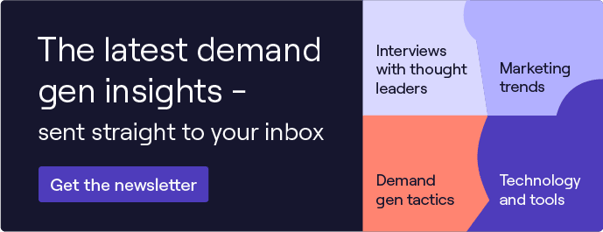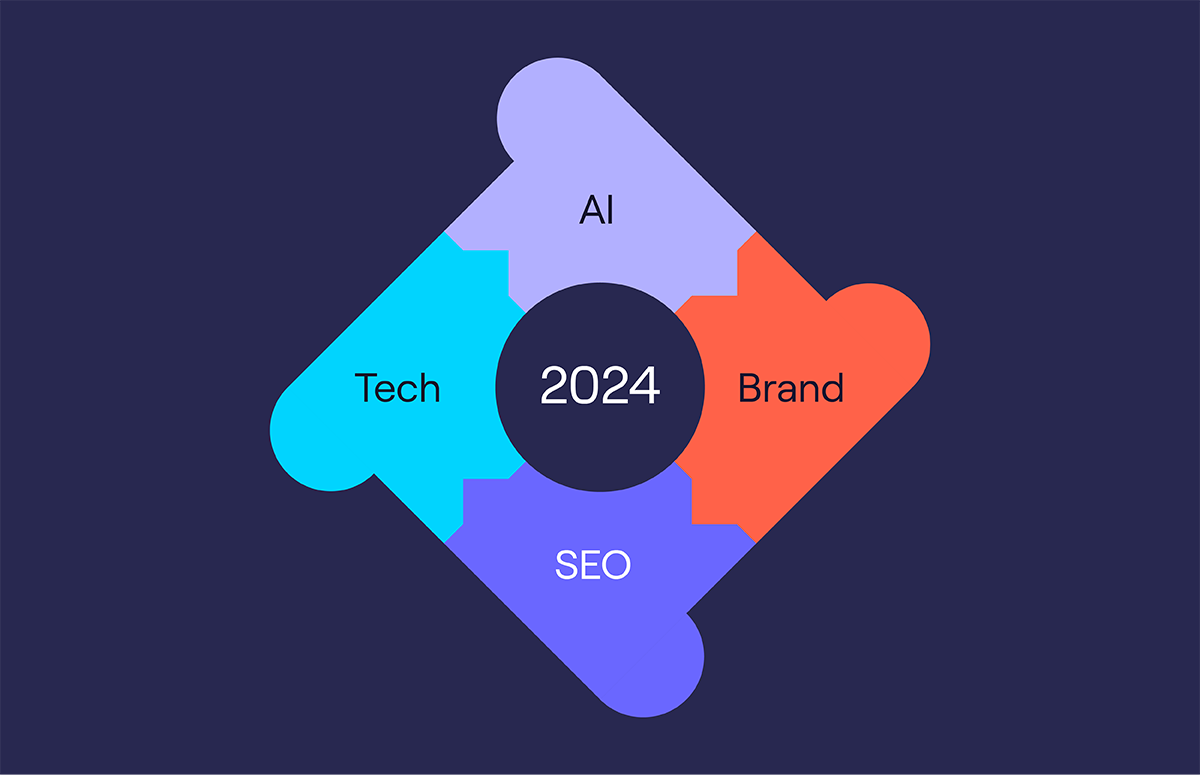Lead Gen to Demand Gen: How to Manage a Marketing Campaign
In Cognism’s old lead gen world, a campaign looked a little different to how we run them now.
Because when the strategic direction of a company and its goals change, so does the way you run your marketing campaigns.
So how do you go from a lead gen campaign to a demand gen campaign? What does a campaign look like in this new world? And how does your attribution change as a result?
We aim to answer some of these questions in this blog. Thanks to the help of our demand generation masterminds, Fran Langham and Liam Bartholomew.
Keep reading to find out what they said!
What did a lead gen campaign look like?
Our old lead gen campaigns revolved around producing and promoting e-books.
They worked like this:
Encouraging people to provide their email address in return for a gated downloadable piece of content. for example a CMO playbook, in order to collect a list of leads.
And that was about as far as a campaign went back then.
Fran shares:
“It was always the same very linear, step-by-step process. We rarely did anything outside:”
- Designing an eBook
- Creating a blog post on the topic
- Creating a specific campaign landing page
- Putting out some ads
- Collecting the leads that came in
“That was kind of it.”
So when the team decided to switch from a lead gen to demand gen model, they didn’t really know what their marketing campaigns would look like moving forward.
Fran adds:
“If we aren’t gating an e-book anymore, in fact we’re ungating all our content… what is a campaign to us moving forwards? And was what we were doing before even a campaign in the first place?”
“Our whole process was changed. Our main focus was collecting inbound marketing leads, that’s where we spent the majority of our time. But now we don’t need to do that anymore.”
“It gave us a sense of freedom, we could start fresh. So we sat down and worked out what we wanted a campaign in our new world to be.”
Running a campaign in a demand gen world
Are you curious to see what our marketing moguls put together for how a campaign would work moving forwards?
Lucky for you, we like sharing!
Campaign definition
Fran, Liam and Cognism CMO Alice started with the important elements they needed their future campaigns to be, do and have:
- Tells a story that resonates with our core persona
- Has a strong narrative throughout
- Has clear creative direction
- Is present across multiple channels
- Made up of multiple content formats
- Feeds into multiple content buckets e.g.:
- Content
- Thought leadership
- Product
- Social proof
Fran adds:
“A campaign isn’t a campaign if it’s just LinkedIn ads, it has to be more than just paid social. This is where we’ve gotten lost before, we never thought about how we could expand our campaign reach.”
“Now we want each campaign to have a strong look and feel about it and have it over multiple channels. This lets us think much more creatively.”
“Focusing on collecting leads really narrowed our vision. But now a campaign can include things like a podcast - and we don’t need to worry about how we collect contact details from it.”
Phase 1: Research and Validate
As the title suggests, we use data and research that we've carried out to design our new campaigns. We then confirm this further by testing our theories and messaging.
Once this is complete, we start to solidify an overarching them to use throughout the campaign.
That process would look a little like this:
- Validate by discussing with immediate DG team members. As well as colleagues in product marketing and customer marketing.
- Listen to customer calls and ensure the campaign is solving key pain points.
- Ensure the campaign is relevant and ahead of trends.
- Take advantage of tools such as Wynter - this helps you to develop messaging that resonates with your audience.
Fran says:
“Wynter is a tool we’ve been using recently and it’s been so helpful. You submit messaging or pages for review by other demand gen leaders or other role titles - depending what you select - and they give you feedback on how it resonates with them.”
“We’ve found this helps us to test if our campaign narrative is something people want to hear about or not.”
Phase 2: Planning
Next comes a more detailed plan of how the campaign is going to come together.
This includes deciding on important aspects of the campaign to bring it to life, including:
- Overarching theme
- Key messaging
- What does success look like? Key objectives to track
- Proposed activation channels
- Any additional content required
- Timeline for proposed actions (campaign flight time = 6-8 weeks)
- Any potential blockers you foresee
- Map out budget and get sign-off for any ‘out of the box’ actions
This is also the point in the process when other crucial members of the team would be looped into the plan.
For example:
- Content team: Map out ideas, set workload and deadlines to produce relevant campaign content.
- Paid team: Share ideas, map out workload, set benchmarks and SLAs.
- Design and video: What assets do yo need during the campaign? So that those assets carry the campaign messaging, what information do you need to share?
- Product marketing: Weighing in on any BOFU elements and advising on key messaging.
Phase 3: Briefing and building
So, you've planned what you're going to need from each team. Now it's time to brief them in more detail and set deadlines.
Make sure you set realistic expectations and timeframes. This will allow proper time to build any creative elements.
A few things to remember in the briefing phase:
- Familiarise yourself with the SLAs agreed with each team.
- Give yourself enough time for revisions if required.
- Ensure the assets are proofread by at least one other team member before final sign-off.
- Use briefing templates
Fran says:
“You don’t need to wait for all your creative assets to be finished before starting to build key elements of your campaign, so get started on the areas you have ready.”
"If you discover any blockers that might knock your campaign off course, you should communicate these with the team as soon as possible. That way, you’ll avoid a domino effect of problems!"
Phase 4: In play and learning
Now this is the fun bit… your campaign is finally live!
But what’s super-important to remember during this phase is that the work isn’t over. Don’t just set it and forget it.
This is the time to observe, learn, analyse and adjust. If you monitor the initial results and find one aspect isn’t working as expected, you can iterate while it’s live. Flag any performance issues with relevant team members for a quick resolution.
Work closely with your content and paid teams; they can help you gather vital results and insights.
Use these campaign insights and data to inform:
- Reports on key results and iterations - feed this info back to the wider team in your weekly meetings.
- In-depth monthly analysis
Phase 5: Reporting and next steps
At this point, your B2B marketing campaign will have been running for 6-8 weeks (and has hopefully been a roaring success!)
So it’s a good time to make some decisions based on what you know now, for example:
- Do you iterate, continue or stop?
- You could refresh the creative or alter the theme or messaging based on what has been validated by results and keep the campaign going
- Or you could stop altogether. The main thing to consider here is: do you need to change some elements to avoid campaign fatigue?
Now is also a good time to start analysing if you reached your target metrics. Was this campaign successful based on the success metrics set in the planning stages?
Some marketing metrics to pay attention to include:
- North star metric = revenue
- Pipeline
- Number of meetings booked and conversation rates down the funnel
- Engagement and feedback
- How is the campaign performing vs benchmarked paid social key metrics and goals?
Fran explains:
“Tracking success in a demand gen world allows us to look at a variety of different areas.”
“Reach is super important. But we also look at things like engagement, qualitative feedback, time spent on page and click through rates. Things that we would have considered to be vanity metrics before.”
“We’re looking to drive revenue, but we also want to stand out, be memorable, and have our audience engaging with us.”
“We care about how we are impacting our customer journey.”
Click play to hear episode seven of Demandism for more Campaign 101 insights! ▶️
Attribution
An important part of any SaaS marketing activity or campaign is tracking its success.
But with demand gen campaigns, how can you attribute which customer came from where? Especially when there are so many touch points involved??
Liam says:
“In a lead generation model, attribution is a lot easier because there’s a main focus on what to track, and that’s how many leads are you generating and what quality they are.”
“When you move to a demand gen model, you lose leads as your core metric, and so there’s a lot more to track.”
Such as:
What was the first thing they saw that brought them in? What was the last thing that got them over the line? What was all the content they consumed in the middle that nurtured them towards a deal?
With so many channels, this is a much bigger challenge than it used to be.
Fran explains:
“When we get to the end of our campaign, we might be able to see that 5 of our deals have interacted with the campaign content in some way.”
“Unfortunately, it’s hard to completely attribute this to the one campaign because they could have been influenced by any number of other factors.”
For example, someone could see the campaign article, listen to the campaign podcast. They might remember the company name but not explore a deal until weeks or months down the line.
They search for you on Google and are attributed as direct traffic, and not due to the campaign - even though it was the campaign that piqued their interest.
Fran says:
“We have some tracking but it isn’t always so reliable. But we don’t mind as long as we’re making memorable experiences. And we tend to see an uptick in inbound requests after the campaign.”
Liam adds:
“You can’t just pay attention to what the last touch was because everything would say Google or ads which doesn’t give you the full picture.”
“One way we try to get around this is to ask people how they found out about us. And their answer might not even be the first place they heard about you, but it could be the thing they most associate with you, like a podcast they enjoyed.”
The team decided that with the move away from lead generation, they’d move away from the contact information forms they used when gating content.
Liam explains:
“We now use as few forms as possible. The only time users need to fill out a form is to register for a webinar or a demo.”
“So, we might not see where that lead comes in through Salesforce, but I don’t feel like that’s any great loss. It didn’t tell us that much beforehand.”
“We can get a good sense of how things are going by:
- Engagement metrics that tell us our most popular content pieces
- Our best lead source using UTMs
- Human attribution e.g. people telling us how they found us.”
In this LinkedIn post, Liam shares some of the marketing metrics he tracks as part of the demand generation model:
Go on now, go and generate demand!
There you have it - that’s how we run, manage and track our demand gen marketing campaigns.
Our final thought:
What a campaign looks like for each company will depend on what your strategic goals are and what kind of outcomes you want. This blog is an insight into how we’ve started to do things.
And no doubt there will be a lot of learning to come. So, if you’d like to follow along with our demand generation trials and tribulations, you can sign up for our bi-weekly newsletter below.



